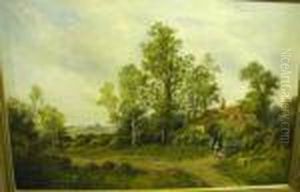Rose Clark Paintings
Rose Clark was an American photographer and watercolorist known for her contributions to pictorial photography during the late 19th and early 20th centuries. Born in 1852, Clark grew up in a period when photography was rapidly evolving as an art form, with various movements and individuals pushing the boundaries of what was considered acceptable in the medium.
Clark's work is often associated with the pictorialist movement, which emphasized beauty of subject matter, tonality, and composition rather than focusing solely on documentation. Pictorialists often manipulated their photographs to create soft-focus effects and sometimes altered them in the darkroom to achieve an aesthetic that was more akin to painting or printmaking than traditional sharp-focused photography.
In her early years, Rose Clark was trained as a painter, which influenced her approach to photography. She became particularly known for her collaboration with Elizabeth Flint Wade, with whom she opened a studio in New York City. The studio, known for its innovative techniques and high-quality prints, attracted a clientele of wealthy patrons.
Clark and Wade experimented with various photographic processes and were known for their skill in gum bichromate printing, a method that allowed them to exert painterly control over their images. This technique involved adding layers of colored gum bichromate over a photograph, giving the final print a richness and depth that emulated the qualities of a watercolor painting. Their work often featured floral subjects, landscapes, and portraits, all rendered with a soft, ethereal quality that became a hallmark of their style.
Despite her success as an artist, Rose Clark's name is not as widely recognized today as some of her contemporaries. However, her contributions to the field of pictorial photography were significant, and her work helped to establish photography as a legitimate and expressive art form during a time when its artistic value was still being debated.
Rose Clark continued to work and exhibit her photographs throughout her life. She passed away in 1942, leaving behind a legacy of artistic achievement that has since been appreciated by historians and collectors. Her photographs are held in the collections of various museums and continue to be studied for their technical mastery and evocative beauty.
